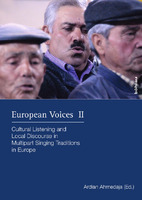European Voices II
Cultural Listening and Local Discourse in Multipart Singing Traditions in Europe
Author(s)
Ahmedaja, Ardian
Collection
Austrian Science Fund (FWF)Language
EnglishAbstract
Although the fundamental meaning of basic terminology is well established for every scholarly discipline, many concepts are often questioned and redefined. In the case of ethnomusicology, this process is all too familiar, as researchers within the discipline focus on the most diverse of music cultures. The manifold worldviews of the resource persons, as holders and presenters (in both meanings of the word) of a tradition make the matter more complex. Such a situation has particular significance in the context of multipart singing because of the specific musical aesthetics and vocabularies established among singing groups. Additionally, it is accentuated by processes of change within every musical culture and those of ethnomusicology.
Examining this question from the viewpoint of folk terminology means primarily considering specific and individual concepts of cultural listening, in the sense of 'paying attention', 'con-centrating' and 'focusing on'. These concepts are established on the one hand through the processes of music listening and music making and on the other hand through the local dis-course, in which singers and musicians as well as local communities are very much involved. The discourse as a communication category with which people communicate about the claim to validity of rules also plays an important role in processes of legitimating and power within the community. An essential part of the discourse is singing itself. The music therefore becomes the object and subject of research. Of particular relevance in this framework are questions of gender, applying to communities in which women practice multipart singing and others where they are mostly listeners, although contributing decisively in the discourse processes.
A specific role become issues of brain research. In this context the functionality of an exact motor control system within the body for precise timing, sequencing and the spatial organisation of movements during musical performance become particularly important. Performing and listening to music are culturally conditioned, but they are at the same time natural human abilities. Therefore the study of underlying processes is crucial and promises to uncover fun-damental properties of the human brain.
The different theoretical viewpoints in the first three chapters of the book are followed by ap-proaches of a "Lexicon of Local Terminology on Multipart Singing in Europe". These reflect the situation of a few but different communities and areas in Europe, helping to obtain additional insights into the topics in question. Die grundlegende Bedeutung der Terminologie steht für jede Wissenschaft zwar außer Streit, viele Termini werden aber oft in Frage gestellt und immer wieder neu definiert. In der Ethnomusikologie ist dieser Vorgang eine all zu bekannte Erscheinung, beschäftigen sich doch die Forscher dieser Disziplin mit unterschiedlichsten Musikkulturen. Die mannigfaltigen Weltanschauungen der Gewährspersonen, die gleichzeitig Träger und Darsteller (im doppelten Sinn des Wortes) der jeweiligen Tradition sind, machen die Frage noch komplexer. Dieser Zustand nimmt in Fragen vokaler Mehrstimmigkeit eine besondere Stellung ein, auf Grund der eigenen musikalischen Ästhetik und des eigenen Vokabulars, die sich unter Sängergruppen etabliert haben. Er wird zusätzlich durch Änderungsprozesse in jeder Musikkultur und jene in der Ethnomusikologie betont.
Diese Frage vom Blickwinkel der Volksterminologie zu erkunden, erfordert zuerst spezifische und individuelle Konzepte des kulturellen Hörens im Sinne von ‚Aufmerksamkeit schenken', ‚sich konzentrieren auf' und ‚Aufmerksamkeit ausrichten auf' in die Untersuchungen mit einzubeziehen. Diese Konzepte sind einerseits durch Prozesse des Musikhörens and Musikmachens, andererseits durch den lokalen Diskurs, in dem Volkssänger- und -musikanten, wie auch die jeweilige lokale Gemeinschaft mitwirken, etabliert.
Der Diskurs als jene Art der Kommunikation, durch die sich Personen über den Geltungsanspruch von Normen verständigen spielt eine wichtige Rolle in den Prozessen von Legitimation und Macht innerhalb einer Gemeinschaft. Ein wesentlicher Teil des Diskurses ist das Singen selbst. Die Musik wird daher Objekt und Subjekt der Untersuchungen. Von besonderer Bedeutung sind in diesem Zusammenhang Gender-Fragen. Sie betreffen Gemeinschaften in denen Frauen aktiv in der Praxis der vokalen Mehrstimmigkeit teilnehmen sowie andere, in denen sie vor allem Zuhörerinnen sind, trotzdem aber eine entscheidende Rolle in den Diskurs-Prozessen spielen.
Eine spezifische Rolle kommt Fragen der Hirnforschung zu. Besonders wichtig in diesem Zusammenhang ist die Funktionalität eines exakten motorischen Kontrollsystems innerhalb des Körpers für die präzise Zeitmessung, die Sequenzbildung und die Raumorganisation der Bewegungen während der musikalischen Interpretation. Musikinterpretation und -hören sind kulturell bedingt, aber sie sind gleichzeitig natürliche menschliche Fähigkeiten. Die Untersuchung der zugrunde liegenden Prozesse ist daher entscheidend und verspricht die Entdeckung grundlegender Merkmale des menschlichen Gehirns.
Die unterschiedlichen theoretischen Blickwinkeln in den drei ersten Kapitel des Buches werden von Annäherungen an ein "Lexikon der lokalen Terminologie zur vokalen Mehrstimmigkeit in Europa" gefolgt. Diese widerspiegeln die Situation weniger aber unterschiedlicher Gemeinschaften und Regionen in Europa und helfen zusätzliche Einsichten zu den gestellten Fragen zu gewinnen.
Keywords
cultural listening; local discourse; multipart singing; European multipart music; local terminology; musical phenomena; Daina (Lithuania); Melody; Music of Lithuania; PolyphonyDOI
10.26530/oapen_437226ISBN
9783205787372OCN
1030815063Publication date and place
2011Grantor
Imprint
BöhlauClassification
Music


 Download
Download